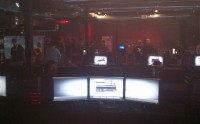This weekend I had the opportunity to attend the Texas Gamexperience hosted by AMD and HardOCP. The show had several interesting things to see but the focus was definitely on the Eyefinity technology by AMD. They also had some extremly cool projectors and gave a lot of tips for projection.
Eyefinity is AMD’s solution for multi-monitor gaming and other applications. The focus today was on its use in gaming to achieve an ultra-wide field-of-view which occupies most of your peripheral vision. The biggest advantage of Eyefinity is that a single graphics card can power all three monitors so there is no need for crossfire or SLI like in days past. A Team Fortress 2 tournament was hosted which pitted a team each using three monitors in Eyefinity configuartion against a team each using a single monitor. Strangely enough, during the final I played in the team with single monitors and we won both matches. So the question seems to be twofold with Eyefinity. Does it enhance the experience? Does it provide a competitive edge?
The second question appears to be easier to answer. The answer is no. I thought at first that perhaps having a wider viewing angle would allow you see enemies out of the corner of your eye but this never really seemed to be the case. I didn’t see any noticeable advantage for any team using Eyefinity. If you’re hoping a three monitor setup will compensate for your gaming deficiencies then you are mistaken. Additionally, there were a few minor complications with the Eyefinity setup. Several messages and notifications would appear on the corners of the outer monitors so they would escape view altogether. This is really problematic for games which are not programmed for Eyefinity. Additionally I noticed the vertical-sync was slightly off at times for the Eyefinity computers, but it was minor.
As far as the experience goes, that’s slightly more complicated. Is it a convincing implementation? Yes. I actually didn’t notice the bezels of the montiors very much and it does seem to fill your entire field-of-view. The problem with the setup is slightly similar to the new push for 3D. Your eyes can get used to anything and after a while you begin to not notice the effect. Perhaps a longer gaming session on a single-player game would be different. In addition to Team Fortress 2 there was an Eyefinity display that was quite impressive.
AMD had brought a couple of D-Box racing chairs and hooked them up to two new computers, each sporting a Radeon 6950 and their new Bulldozer chip. Each 6950 then powered three projectors all configured in Eyefinity. This produced one of the most convincing racing sims I’ve ever played. Eyefinity with a first-person racing game across three large projector screens is something that has to be experienced. Will it happen in your home, sitting atop a $7,500 racing seat? Probably not unless you are unmarried, have a huge house and tons of disposable income.
Texas Gamexperience Dirt 3 demo
Eyefinity for competitve gaming seems to be a dose of snake oil from my experience today but, on the other hand, if you’re looking for a way to get a more immersive gaming experience, it definitely has potential. Thanks again to HardOCP and AMD for putting on a great event.


I think that part of the problem might be that a huber FOV results in
more “distance”. Between you and the enemy, making them harder to hit unless you are already used to a higher FOV, and have your mouse configured properly for higher FOV. It is possible that the players using Eyefinity were simply not used to the different style of play.
Also, I’d have to point out that Team Fortress 2 isn’t the best game to judge player performance based on FOV, since the focus of TF2 leans heavily on team dynamics rather than raw aiming skills. Quake 3, on the other hand…
Ignore the typos… For some reason this automatic spell check changed “higher” to “huber”… And my thumb may have hit a couple of extra characters by accident…